Ventilation in a private house from aerated concrete: options and methods of construction
Aerated concrete in recent years has gained wide popularity. More and more people are choosing this material for the construction of their homes. It attracts with an affordable price, excellent technical characteristics and technological advantages: work with it progresses much easier and faster than with brick.
Often, the owner of a new home primarily considers it necessary to conduct electricity, heating, water and sewage into the home, forgetting or intentionally pushing the ventilation system into the background. So is ventilation in a private house of aerated concrete necessary? And if so, which one is better to choose? Yes, and how to do it?
You will learn all about the value of the ventilation system in the house from aerated concrete blocks from the article we proposed. We will introduce the types and specifics of the organization of communications that ensure stable regulatory air exchange. Let's talk about the features of their device.
The content of the article:
Why is ventilation needed?
For a comfortable stay of a person in a work / residential / utility room, certain microclimate parameters must be supported: lighting, temperature, humidity, oxygen, carbon dioxide concentration, permissible percentage of airborne contaminants, etc.
You probably noticed that sometimes even at a comfortable temperature we feel stuffy, damp and uncomfortable. Smells from the kitchen or bathrooms scatter throughout the house and do not disappear for a long time, and in the rays of sunlight, countless dust particles are visible. Unfortunately, many homeowners are familiar with these situations.

The cause of all these troubles in most cases is a malfunction or lack of a ventilation system. After all, it is she who is responsible for removing the exhausted air mass from the room and supplying him with a fresh and clean stream.
Since school, we know that in the process of breathing and life, a person consumes oxygen and releases carbon dioxide and moisture into the air around us. Also, a lot of moisture gets into the air when washing and drying clothes, cooking, wet cleaning, taking a shower.

We constantly, without thinking about it, bring home dust on clothes and things. The atmosphere within confined spaces is literally teeming with volatile microscopic organic and mineral contaminants, animal hair.
If the house is not ventilation systemsthen all moisture, dust and CO2 accumulate in the air. In this case, the amount of oxygen, on the contrary, decreases, making our stay in the room unbearable. If you ignore this state of affairs for a long time, then you may experience problems with well-being and health.
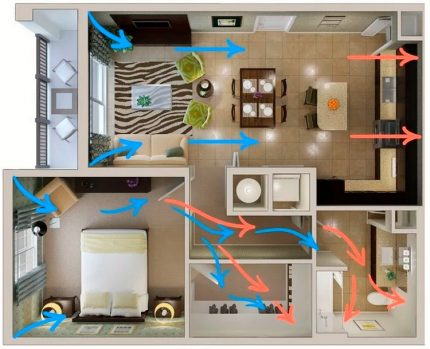
Without a stably set air exchange in a house with walls, condensate will not be removed from the aerated concrete blocks in a timely manner. As a result, a fungus settles in building structures, destroying both building materials and the health of owners with households.
Sanitary regulations
In contrast to private developers, employees of design organizations and sanitary doctors are well aware of the importance of air exchange in residential buildings. Therefore, ventilation along with heating, water supply, and lighting are devoted to entire sections of regulatory documents.
Here are some of these rules:
- SP 13330.2016 Heating, ventilation and air conditioning. Updated edition of SNiP 41-01-2003;
- SanPiN 2.1.2.2645-10 “Sanitary and epidemiological requirements for living conditions in residential buildings and premises” (Section IV. Hygienic requirements for heating, ventilation, microclimate and air environment of premises);
- “SNiP 2.08.01-89 *. Residential buildings ”(Section 3. Heating, ventilation and air conditioning. Appendix 4 (mandatory). Design air parameters and air exchange rate in the premises of residential buildings).
Briefly, the requirements of these rules look like this:
- All residential buildings must have a ventilation system;
- The ventilation system with a specified frequency should ensure the replacement of exhaust air with fresh;
- The air outlet from the premises of a residential building should be provided through the exhaust ducts of kitchens, latrines and bathrooms (showers).
But such standards for the amount of air removed are established by the rules:
| Room | The amount of air removed from the room |
| Living room | 3m3/ h at 1 m2 premises |
| Kitchen with electric stove | Not less than 60 m3/ h |
| Kitchen with 2xcomfortable gas stove | Not less than 60 m3/ h |
| Kitchen with 4xcomfortable gas stove | Not less than 90 m3/ h |
| Bathroom | Not less than 25 m3/ h |
| Restroom | Not less than 25 m3/ h |
| Combined bathroom and toilet | Not less than 50 m3/ h |
Let's calculate the volume of air exchange for a two-story house with four rooms with a total area of 80 m2, two combined bathrooms and a kitchen with a 4-comfortable gas stove:
Standard for rooms = 80 m2 * 3m3/ h at 1 m2 premises = 240 m3/ h;
Standard for the kitchen = 90 m3/ h;
Standard for bathrooms = 2 bathrooms * 50 m3/ h = 100 m3/ h
TOTAL: 430 m3/ h
Exactly such air exchange it is required to provide in our conditional house for a comfortable state of health and to preserve the furnishings in good condition.
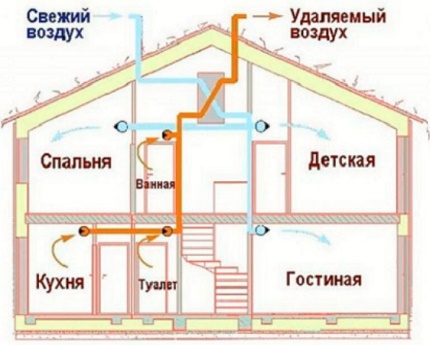
Concluding the topic of standards, it should be noted that it is important not only to achieve normative air exchange, but also not to overdo it. After all, the greater the air exchange, the higher the speed of the air flow through the rooms, and if its values are excessive, negative phenomena can occur - drafts.
Ventilation schemes for houses made of aerated concrete
In general, ventilation systems can be divided into two main groups - natural and forced (mechanical).
Natural scheme It works due to the temperature difference and the density of air mass inside and outside the building. It is completely autonomous, operates independently of the supply of electricity. However, the closer the outside temperature to room temperature, the worse the air exchange will be, up to a complete stop.
This is especially felt in the summer. To achieve high performance in natural ventilation is problematic. Especially if it is arranged according to the channel principle with numerous twists and turns: the more complex the scheme, the weaker the thrust;
Mechanical circuit much more powerful than the natural system. It is often supplied with additional functions of heating or cooling the air, the function of heat conservation (recovery), the ability to integrate into the Smart Home system. Such ventilation works regardless of temperature changes.
Both types of systems are united by the fact that it is desirable to think over both natural and mechanical ventilation at the design stage of the house and install it immediately, during its construction.
Why is it important? Because the ventilation system, in most cases, is a network of metal or plastic ducts, which must be laid out of the premises and brought to the roof.
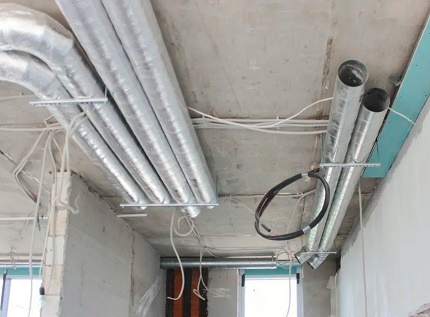
If you do not immediately take into account all the nuances of installation, then the ventilation device in the future can be fraught with many difficulties (punching or drilling holes in the main walls and floors, the need to lay pipes from the premises of the first floor through the living rooms of the second, ugly appearance, etc.).
Despite the apparent complexity, to understand the organization issues in order to mount the ventilation in aerated concrete Do-it-yourself house or competently order its installation, without overpaying for equipment and work, quite simply.
So, let's move on to the types of ventilation.
Subtleties of natural ventilation
We have already figured out that the force that makes natural ventilation work is the desire of warm air to rise up. In order for such a movement to begin, an air duct is needed that allows warm air from the room to exit onto a colder street.
Ducts are made of plastic, galvanized metal or stainless steel round pipes or square or rectangular sections. Also ventilation ducts can be made in the form of voids in the walls during their construction.
If the above pipes are laid in such voids, then this is called by sleeve, this method is widely used, as it eliminates masonry leaks and facilitates maintenance.
With natural ventilation, the air ducts are made vertical and as straight as possible, and the number of turns and horizontal (inclined) sections is minimized, as this reduces traction. Also, for better traction, you can’t narrow down pipe diameter.

Exhaust vents are equipped with ventilation grilles. They are installed in the upper quarter of the walls or directly under the ceiling, since it is there that air rises, requiring removal.
The air flow in natural ventilation schemes occurs through leaks in building structures, windows and doors, as well as through special air inlets located at the bottom of the house.
Windows made of plastic and safe doors practically do not let air through. Therefore, when installing natural ventilation in modern housing, the presence of air inlets or valves is a prerequisite for the operation of the ventilation system.
The easiest solution is to install windows with vent valves. They will allow without the production of additional holes to ensure the flow of fresh air into the room.
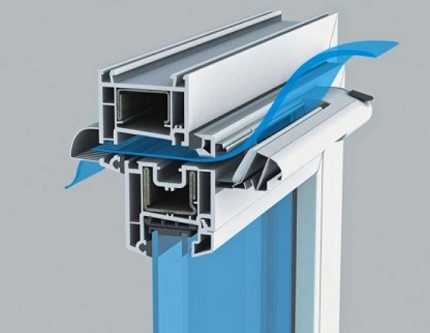
But do not despair if the windows in the house are installed without such valves. For these cases, wall mounted devices are available on the market. They have a significantly greater throughput than window ones, and can also be equipped with filters, which allows you to clean the air before it is fed into the housing.
It is worth remembering that yourself wall valves they cannot ventilate the room. For their work, a built-in exhaust or supply fan should work. The valves simply let air in through the street and allow you to adjust its flow by opening or closing the damper.
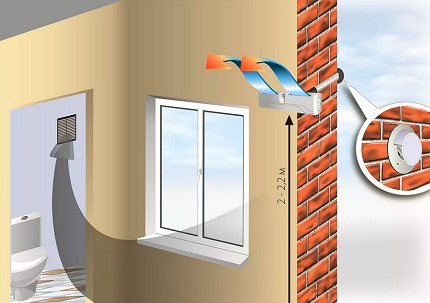
Natural ventilation is good for its simplicity, low cost and non-volatility. It is easy to carry out its installation with your own hands. It can be a great solution for small houses.
The nuances of organizing mechanical ventilation
The difference between a mechanical ventilation system and a natural one is that the air is driven by electric fans. Due to this, mechanical ventilation can have a complex and long system of ventilation ducts with both vertical and horizontal sections.
Pressure losses in ducted mechanical ventilation options are compensated by an increase in fan power. This allows you to hold the ducts in all the necessary rooms, without worrying about the lack of traction.
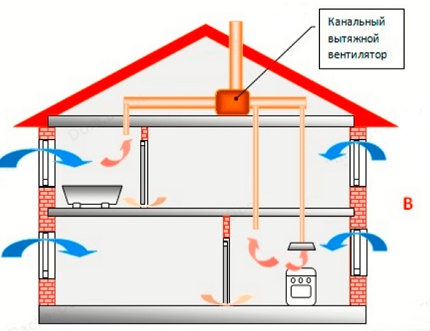
Another distinguishing feature of a mechanical ventilation system is the ability to automate it. Thanks to the installation of fans with multi-stage speed control, as well as other devices that control the speed, direction of the air flow and its temperature, mechanical ventilation allows for optimal air exchange in each room.
It is more profitable to equip a private house with a mixed ventilation system, which includes components of both gravitational and forced type. In these schemes, air movement is stimulated by a fan mounted either in the inlet or in the exhaust.
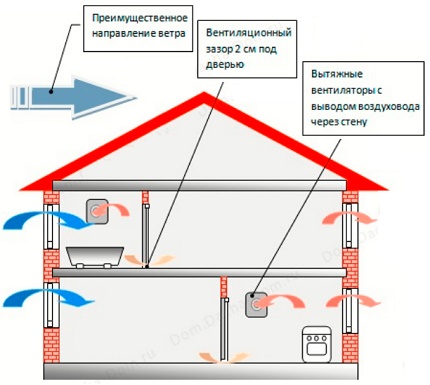
Mechanical and mixed ventilation can be local and centralized.
With a local ventilation system in each room from which air is removed, its own fan is installed. A typical example is a kitchen hood and a fan on the exhaust hole in the bathroom.
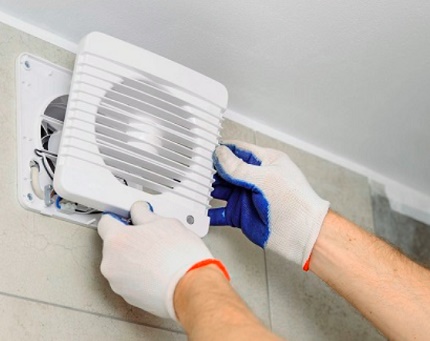
Such a solution is often applied if, for some reason, the draft of natural ventilation was not enough and it is necessary to increase it. Installing local exhaust fans low cost a way that you can do it yourself.
Both for the natural scheme, and for mechanical exhaust ventilation, the presence of air flow paths through leaks, or through special inlet openings or valves, is mandatory.
With a centralized ventilation system in the house, usually in the attic, an exhaust unit is mounted or supply and exhaust ventilation. Further, from this unit, ventilation ducts are laid into the necessary rooms to remove the exhaust air, and if the supply and exhaust system is installed, then they will be fresh.

Supply and exhaust ventilation units are equipped with two fans and ensure equal amounts of incoming and outgoing air. Also, such installations can be equipped with heating systems and filtering the incoming air and automation, which allows you to maintain the specified temperature and air exchange.
Recovery ventilation units equipped with a device that increases the economic effect of the use of equipment. This is a recuperator that provides the ability to rationally manage the energy of heating systems and save on utility bills.
With any other type of mechanical ventilation, heat is simply emitted from the room to the street along with the exhaust air! Savings from recuperated ventilation especially relevant in winter, when a lot of thermal energy flies into the ventilation pipe. At the same time, the cold air coming in from the street must also be warmed up to room temperature.
The recuperator is a heat exchanger through which warm air from the house and cold air from the street pass simultaneously. In some models of recuperators, additional plate heaters with freon or water are used.
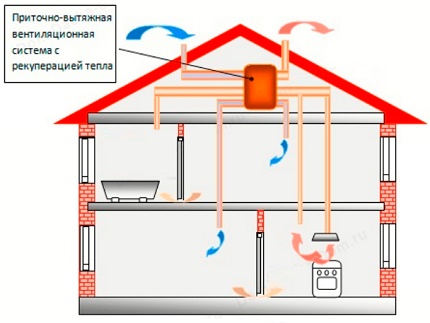
Thus, fresh air is not heated by heating or electricity, but by previously heated air removed from the room. Heat losses in the case of a recuperator are minimal.
In warm times, when it is hot outside, the recuperator is also useful: in this case, it cools the hot air coming from the street with cooler air from the room, reducing air-conditioning costs.
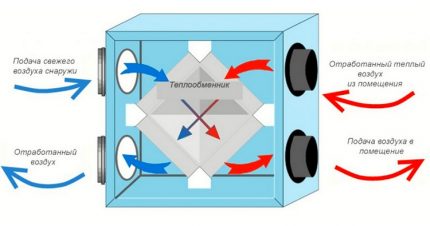
Unfortunately, with obvious advantages, recovery has two drawbacks:
- Firstly, ventilation units with recuperation are several times more expensive than similar units without a recuperator;
- Secondly, recuperators can only work stably when the street temperature is not lower than - 10 aboutC. At colder temperatures, the plates become icy.
However, even with its shortcomings, a recuperator is the best solution for systems that process all the rooms in the house. Among local options, the breather is in the lead.
Breather - This is a device for ventilation in a single room.It consists of a ventilation duct and a housing in which are installed: electric heater, fan, filters, shutters and automatic control.
For convenience, the settings breathers maybe a remote control. Some breathers equipped with a ceramic heat exchanger, which allows them to work in recovery mode.
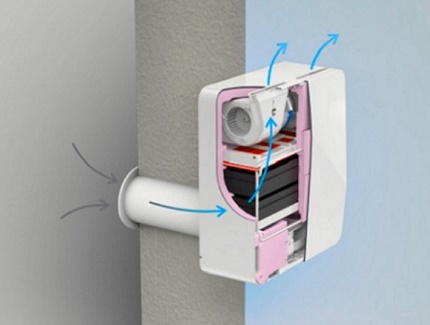
Breathers Forced fresh air is forced into the room by pre-filtering and, if necessary, heating it. Models with a heat exchanger can not only pump air into the room, but also remove the old one from it.
Self-contained installation in aerated concrete house breathers and valves does not cause difficulties: you just need to drill a hole in the wall of a suitable diameter under the ventilation pipe and fix the device on the wall.
Ventilation air purification
At the beginning of the article, dust flying in the air with improper or absent ventilation was mentioned. To solve this problem, modern ventilation systems can be equipped with special filters to clean the air entering the room from the street.
At the same time, depending on your needs, the set of filters can be different: from rough cleaning, delaying only large particles; to fine cleaning, not even letting in smells and pollen.

There is only one drawback with filters: they need to be changed periodically.
Chimneys of stoves and fireplaces in residential premises
If you are planning or already own a stove or a fireplace in your house, then when calculating the ventilation, you need to keep in mind that the chimneys of stoves and fireplaces are actually exhaust ventilation.
In the cold state, the chimneys work like a normal natural exhaust, and when burning wood, this effect is greatly enhanced, since a large amount of air is consumed for burning.
And although chimneys cannot fully fulfill the function of exhaust ventilation, their presence must be taken into account when determining the size of the supply openings so that they can provide the required fresh air flow both for the main ventilation and for the operation of the heating device.
DIY installation of a ventilation system
Now on the Internet there is any information about the selection and installation of ventilation systems, which in a house from aerated concrete can be built without problems with your own hands. At a hardware store, you can freely buy ventilation ducts, fans, or serious ventilation installations.

The only thing that is better to entrust to the designers is the calculation of ventilation, because it is unlikely that it can be done independently without knowledge.
Correct calculation is especially relevant if you plan to use natural ventilation, because in this case it is important to choose the right amount and cross section ventilation ductsso that they provide the necessary traction and air exchange.
If you plan to install mechanical ventilation, then an approximate calculation of its performance can be done based on the standards, as in the example indicated at the beginning of this article. To do this, you need to calculate the standard ventilation value for your home and increase this value by 10-20% to compensate for losses during air movement along ventilation ducts.
As for the installation of ventilation itself, for people building a house with their own hands, as a rule, there is nothing complicated.
Ventilation ducts are assembled as a designer when one part is freely inserted into another. A large number of lengths, shapes and sections of channels, as well as various bends, tees, transitions, valves, gate valves and other products allow you to assemble a ventilation duct of any configuration.
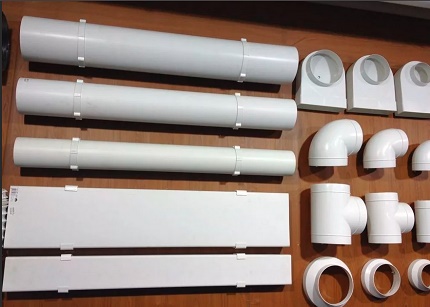
Also, due to standardization of sizes, ventilation ducts can be connected to a wide variety of supply, exhaust and supply and exhaust mechanical ventilation systems without problems.
The choice of such plants and their manufacturers, by the way, is also great: from budget ones with simple functionality, to premium ones with full automation.
Conclusions and useful video on the topic
The following video will familiarize you with the features of the device for the air exchange system in the house from aerated concrete:
Properly selected and installed ventilation in the house from gas block - This is the key to well-being and health of households. Natural ventilation is suitable for small houses, and for large buildings with many rooms, the best solution is a mechanical system.
You can choose and install ventilation both independently and entrusting it to the builders, but in both cases it is recommended to do this at the design stage (planning) and construction of the house.
Do you want to share your own experience in building a ventilation system in a house from aerated concrete blocks? Please leave comments in the form below the block. In it you can ask questions, post a photo on the topic of the article, give useful recommendations to site visitors.

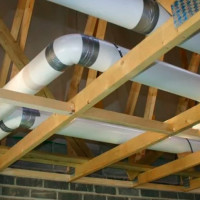 Ventilation from plastic sewer pipes in a private house: the possibility of construction and the best options
Ventilation from plastic sewer pipes in a private house: the possibility of construction and the best options 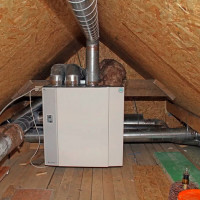 Ventilation in a two-story private house: options for organizing trouble-free air exchange
Ventilation in a two-story private house: options for organizing trouble-free air exchange 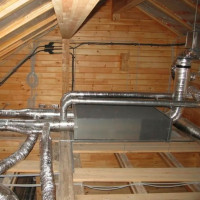 Is it possible to bring ventilation to the attic in a private house? The best accommodation options
Is it possible to bring ventilation to the attic in a private house? The best accommodation options  Ventilation in a private house: supply and exhaust systems + tips for arranging
Ventilation in a private house: supply and exhaust systems + tips for arranging  Ventilation in the house from sip panels: the best options and layouts
Ventilation in the house from sip panels: the best options and layouts 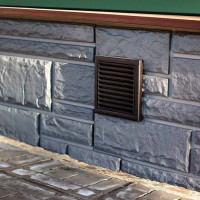 Natural ventilation in a private house: rules for arranging a gravitational air exchange system
Natural ventilation in a private house: rules for arranging a gravitational air exchange system  How much does it cost to connect gas to a private house: the price of organizing gas supply
How much does it cost to connect gas to a private house: the price of organizing gas supply  The best washing machines with dryer: model rating and customer tips
The best washing machines with dryer: model rating and customer tips  What is the color temperature of light and the nuances of choosing the temperature of the lamps to suit your needs
What is the color temperature of light and the nuances of choosing the temperature of the lamps to suit your needs  Replacement of a geyser in an apartment: replacement paperwork + basic norms and requirements
Replacement of a geyser in an apartment: replacement paperwork + basic norms and requirements